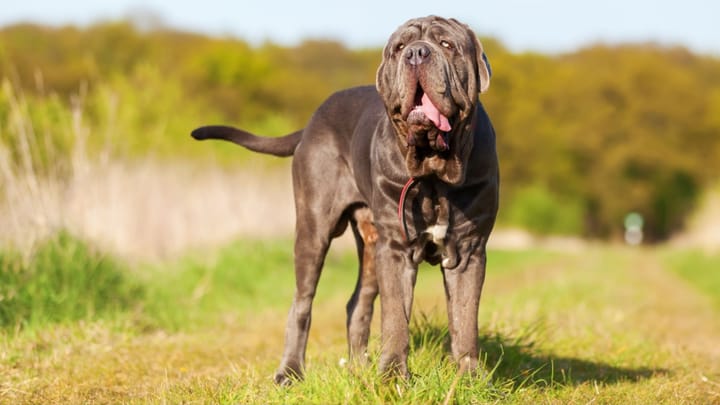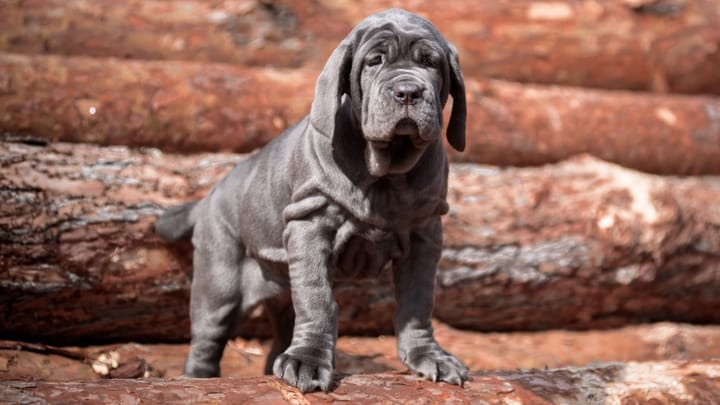Neapolitan Mastiff
Other names : Mâtin napolitain, Mâtin de Naples, Mastino Napoletano


The Neapolitan Mastiff is an extremely balanced dog - never unnecessarily aggressive, gentle and safe around children: they become challenging when provoked. They are mainly a guard dog, but also a companion and exhibition dog. Of all the Molosser guard dogs, the Neapolitan Mastiff has the calmest character.
|
Life expectancy |
The Neapolitan Mastiff has a life expectancy of between 8 and 10 years |
|
Temperament |
|
|
Size |
Large
|
|
Adult size |
Female
Between 24 and 27 in
Male
Between 26 and 30 in
|
|
Adult weight |
Female
Between 110 and 132 lb
Male
Between 132 and 154 lb
|
|
Coat colour
Generally, the coat is grey, lead-grey or black. They can also be black, fawn or deer-red. All colours can be brindle. |
Black Blue Red |
|
Type of coat
The hair is short, even cropped. The hair is dense, of a rather coarse texture and the same length all over the body. |
Very short Hard |
|
Eye colour
Often, the iris is darker than the colour of the coat, except for softer coats, where the iris is clearer in this case. |
Brown
|
|
Purchase price |
The Neapolitan Mastiff costs between £1330 and £1370 |
For future adopters, do not be surprised: the Neapolitan Mastiff drools a lot and is often very flatulent.
More details about the Neapolitan Mastiff
Neapolitan Mastiff: Origins and history
Like all Molossers, the Neapolitan Mastiff most likely descends from the old Tibetan Molossus: they lived in southern Italy for at least 2,000 years BC. At the time of the second world war, the breed was close to extinction: it was recovered and saved in 1946 by the Italian writer and dog lover Piero Scanziani, who reconstructed the breed from the few remaining dogs. The breed was officially recognised in 1956.
Physical characteristics of the Neapolitan Mastiff
The Neapolitan Mastiff is a large dog, a Molosser, with thick, characteristically wrinkled skin, covered with short fur. Their head is enormous and short, with a round skull, but flattened between the ears. They have a straight muzzle, a big nose and thick, drooping lips. Their eyes are far apart, the opening of the eyelids is almost round. However, as the skin supporting the eyebrows is very thick, this opening appears actually rather oval. The ears are small compared to the dog’s body, they are triangular in shape and placed high above the zygomatic bone. The whole body is longer than it is tall, with a massive neck and dewlap; the hindquarters are wide.
Neapolitan Mastiff: Characteristics
Neapolitan Mastiff: Behaviour
Training a Neapolitan Mastiff
Able to be quite stubborn at times, the Neapolitan Mastiff is not to be put in the hands of a beginner, who could quickly be overpowered. Sometimes temperamental, this dog needs clearly defined boundaries from an early age. Given their imposing size when fully grown, the Neapolitan Mastiff puppy must conform to the needs of their adoptive family.
The key points to work on positively, consistently and early on are: walking on a lead without pulling, avoiding lagging behind the dog during walks and to prevent their very protective nature from excessively impacting their owner’s daily lives, especially during socialisation.
Although firm, training methods must always be positive. The slightest cruelty would only destroy the dog-owner relationship that must be based on mutual respect and trust.
Neapolitan Mastiff: Lifestyle
Breed compatibility Neapolitan Mastiff
Neapolitan Mastiff: Purchase price
The price of a Neapolitan Mastiff varies according to the origin, age and sex. A pedigree usually costs around £1,370.
Regarding the average budget needed to meet the needs of a dog this size, it would cost approximately £70 a month.
Neapolitan Mastiff: Shedding
Average
The Neapolitan Mastiff loses a moderate amount of hair, which remains the same during moulting periods.
Neapolitan Mastiff: Grooming
Maintaining this dog is absolutely not complicated but still needs to be rigorous to a certain extent. Their short hair doesn’t need to be brushed every day, but their skin folds must be closely monitored as they are often the cause of certain skin diseases.
Brushing at least once a week is enough to maintain the beauty of their coat. Their delicate eyes must also be monitored and cleaned regularly.
Neapolitan Mastiff: Health
The life expectancy is estimated at approximately 9 years.
For their size, this Mastiff is particularly robust, although they do not have the best longevity. The health problems they can encounter are often related to their size and morphology.
Originating from a warm country, this breed can deal with the heat rather well.
These dogs suffer from the cold. Ideally, these dogs will be able to go in the garden during daylight hours but will need to return indoors at night.
Since they aren’t the most athletic dogs, the Neapolitan Mastiff can put on weight. It’s therefore important to walk them every day (even if just at a leisurely pace) and to ensure a balanced diet.
- Hip and elbow dysplasia
- Cardiomyopathy
- Eye problems (entropion, ectropion, cataracts, prolapse of the Harderian gland)
- Skin problems (demodicosis, dermatitis etc.)






